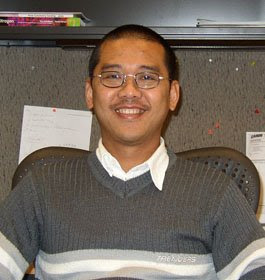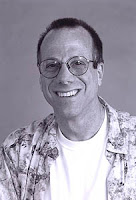Tuesday, July 8, 2008
WHAT SKILLS ARE IMPORTANT?
-Synthesis/Reorganization - Reorganizing information to get a better approach to problems or tasks.
-Monitoring - Assessing how well one is doing when learning or doing something.
Information Organization - Finding ways to structure or classify multiple pieces of information.
-Product Inspection - Inspecting and evaluating the quality of products.
-Communication and Media - Knowledge of media production, communication, and dissemination techniques and methods including alternative ways to inform and entertain via written, oral, and visual media.
WHAT DO FILM AND VIDEO EDITORS DO?
Film and Video Editors perform the following tasks to complete a film:
-Evaluate and select scenes in terms of dramatic and entertainment value and story continuity.
-Trim film segments to specified lengths and reassemble segments in sequence that presents story with maximum effect.
-Use editing equipment to insert music, dialogue, and sound effects.
-Review assembled film or edited videotape on screen or monitor and make corrections.
-Work with Sound Effects Editors and Music Editors.
Sound Effects Editors perform the following tasks to provide sounds that match the action on screen:
-Work with Film and Video Editors, directors, and other technicians to analyze the sound requirements of the picture. -Record needed sounds or obtain them from sound effects libraries. -Assemble sound tracks recorded after action is filmed.
Music Editors perform the following tasks to enhance the film with background music:
-Discuss the music requirements of the film with directors and composers before they select music for a film. -Describe each scene and note the required length of time for composers. -Use music libraries to find the proper music for productions that do not use original scores. -Synchronize music tracks with the picture after the music is composed and recorded.
Assistant Editors perform the following tasks:
-Prepare the work for Editors.
-Provide general support services for Film Editors. -Maintain schedules and arrange screenings for directors and producers.
-Supervise apprentices.
Increasingly, films and television productions are edited on computer editing equipment, although feature films are still edited in the traditional way on flatbed editing machines called Moviolas. In the traditional method of editing, Editors run strips of film through these machines at various speeds. They mark frames where a particular shot or piece of sound is to begin or end. After the scenes are edited, Assistant Editors join separate strips of film on a splicer. The sequences are then ready for viewing. Computer editing uses personal computers and special software to rearrange film sequences.
In the television industry, almost all work is done on videotape rather than film. Videotape editing requires some additional special training on the various electronic equipment used in the editing process.
Nokia 6265 cdma
 This is NOKIA 6265 cdma phone. A winning combination of design and technology. its include 2 megapixel camera, MP3 player, bluetooth, expandable memory and high quality display. seriously its more than a phone.
This is NOKIA 6265 cdma phone. A winning combination of design and technology. its include 2 megapixel camera, MP3 player, bluetooth, expandable memory and high quality display. seriously its more than a phone.Liem Nguyen :3d animator

LN: I grew up on the old Tom n' Jerry, Mickey Mouse and Bugs Bunny cartoons. As a kid, I remember waking up at 6am just to catch the Saturday morning cartoons on television. Later on, films like Jurassic Park and The Fifth Element made a huge impact on me. They inspired me to learn as much as I could about this new technology and art form.
In terms of becoming an animator, I didn't just wake up one morning and decided to be one. Rather, it was more of a gradual evolution. I turned my love of cartoons into a passion for drawing, which led to an education in traditional animation. That path eventually transitioned into 3D animation, where I am today.
AA: When you made the decision to be an animator what was the first step you took to make your dream a reality?
LN: If you think of reaching your dream as a journey, it's a good idea to be fully equipped and prepared before venturing out. The first step for me was simply research. I wanted to learn as much as I could about the animation world. This included borrowing animation history books from the library, renting animation classics from a video store, subscribing to animation magazines, checking out animation studios online and talking to some animators at the National Film Board headquarters in my city.
AA: You attended the prestigious Sheridan College known for their animation program, can you tell us about your experience at Sheridan College?
LN: The four years that I spent at Sheridan College made a huge and positive impact on my life and career. Granted, the college has top-notch facilities, great instructors and a finely-tuned animation curriculum over the years. but the real value was in us, the students. Having such a prestigious reputation, Sheridan College attracted many artists and animators from around the world. This collection of talent and ambition created a synergy - a competitive yet friendly atmosphere where everyone always strived to do better.
AA: Were your animation classes very competitive?
LN: Yes, the classes were very competitive. A perfect example of this was one of our first assignments. The task was to animate a round ball swinging back and forth on a pendulum. The students managed to turn this simple and straightforward assignment into a complex and competitive ordeal. Some people had beautifully shaded grandfather clock mechanisms, while others had the ball bouncing around on very extravagant paths, missing the whole point of the exercise. Nevertheless, it was fun working in that kind of competitive environment.
AA: What type of classes did you take while studying to become an animator?
LN: Some of the classes included layout and design, character design, life drawing, storyboarding, animation history and of course, animation. On occasion, we would have guest speakers from Pixar, Dreamworks, Square and Nelvana to name a few. We also made class field trips to the zoo, museum and Royal Winter Fair to sketch people and animals. In our final year, the thesis was to combine everything we had learned in these classes and produce our own animated short film, from beginning to end.
AA: If you could do it all over again is there anything you would change about your experience in animation school?
LN: All in all, I cherished every moment of my time at Sheridan College. During that time, I learned a lot of new things, improved my skills dramatically and had a great time. Equally important, I made a lot of new friends whom have all gone on to work at different studios around the world.
AA: How important is it for aspiring animators to attend College/Art School? Do you think formally trained animators have an advantage over self taught animators?
LN: There are advantages and disadvantages to both methods. What it all boils down to is the individual's determination, skills and attitude. And besides, the real training begins once an animator gets a job and works together with other people in a production environment.
AA: How did you get your first paying job as an animator and how old were you?
LN: I was 18 when I first got paid for doing animation. By chance, one of the directors from Frantic Films saw my animation line tests when I was in high school and offered me an internship at his company. That summer, I shared a tiny one room apartment office with three other animators, doing animation and special effects. There, I started with 3D Studio Max tutorials on a Pentium 66 MHz with a fuzzy, 14-inch CRT monitor and nearly went blind. But I didn't mind because I felt grateful for the opportunity to hang out and learn from my mentors. My first real work there was to animate a fleet of jumbo jets flying across the sky. I poured my heart into the models, the realistic texturing and animation. When the commercial finally aired on television, it was a blur in the distance that barely lasted over a second. Needless to say, it was my proudest moment up to that point.
AA: Did art school fully prepare you for your first job as an animator or did you experience a lot of growing pains?
LN: It's impractical to expect school to fully prepare you for the real world. If you keep an open mind you really never stop learning - whether you're sitting in the classroom, starting your first day on the job or directing your twentieth feature film. In a way, what school can successfully do is instill this perceptive spirit in you. After graduating from Sheridan College, I could never watch an animated movie without analyzing it to bits in my head - which can be viewed as a gift and a curse!
AA: You have experience working in many different industries - everything from Movie Visual Effects, Video Game Development, Television Commercials, Animated children's programs and more. Could you tell us which industry was most enjoyable and offered the most creative freedom and which industry was the least enjoyable to work in?
LN: It would be unfair to single out one industry as better than the others. What if I tell you what aspects I did enjoy from each one instead? In movie visual effects, the production schedule is quite long. Therefore, you have a lot of time to focus on the quality and perfect your work. On the downside, you are often at the whim of eccentric movie directors whose last-minute decision can render your months of hard work obsolete. With video games, you get the satisfaction of providing endless hours of enjoyment to a large audience of your peers. With television commercials, you get the thrill of working on something totally different every couple of weeks.
AA: What advice would you give to our readers who want to work for video game companies and what they can expect? What should they not expect?
LN: I've worked for a couple of video game studios including EA Games in Vancouver, Canada. One common misconception of 3D artists is that they will have a lot of variety and creative input in the design of a title. In fact, you're a small but vital part of a larger vision. For example, your specific job might be to clean up the motion capture or perhaps model a character based on conceptual artwork provided to you. Furthermore, technical restraints of video games such as polygon counts further limit your freedom. However, working in a team can still be a very rewarding experience and you get a chance to really excel at the one thing you do.
AA: How competitive is the animation field?
LN: It depends on how you look at it. True, there are a lot of other animators out there that you have to compete with. But why not use that to your advantage? Building good relationships, collaborating and learning from others is the key to being successful in this industry. This may sound cliché but it's true - the 3D animation industry is a tightly knit community where you run into the same people all the time. A majority of the work I get is through social networking and receiving recommendations from fellow animators. On the flipside of that, I try to share knowledge and help out others whenever I get the chance.
AA: Which piece of art in your portfolio are you most proud of and why?
LN: The Little Bopeep animated short film that I am currently working on is what I am most proud of. A few years ago, my Sheridan roommates and I came up with the idea - a modern retelling of the Bopeep nursery rhyme. Our version includes a demented shepherdess who builds a sheep-cloning machine to replace her flock that has gone missing. I enjoy working on it because it's such a collaborative effort. Over the years, at least a dozen artists have contributed to it. Currently, you can view the entire animatic and some character designs on my website (www.pixelreborn.com). I am hoping to post some 3D character models and animation tests soon.
Monday, July 7, 2008
interview of Sir Gladstone "animator Disney Studio"
 The term "persistence of vision" describes the optical phenomenon that makes animation possible. The human eye retains an image for a split second after the source of the image disappears, so when 24 frames per second of an animated film zip through a projector, the flow of motion on the screen looks seamless.The same phrase could also be applied to the mind-set of a young (or not quite so young!) person who has his or her heart set on becoming a Disney animator. For generations, the debut of each Disney animated feature film has ignited in the minds of thousands of individuals the desire to be a part of the marvel they see on the
The term "persistence of vision" describes the optical phenomenon that makes animation possible. The human eye retains an image for a split second after the source of the image disappears, so when 24 frames per second of an animated film zip through a projector, the flow of motion on the screen looks seamless.The same phrase could also be applied to the mind-set of a young (or not quite so young!) person who has his or her heart set on becoming a Disney animator. For generations, the debut of each Disney animated feature film has ignited in the minds of thousands of individuals the desire to be a part of the marvel they see on the screen.
What does it take to be a Disney animator? What spectrums of talent and elements of training are needed to produce these wonder-working "actors with pencils" called animators?
Gladstone begins by explaining that natural talent will come out at a young age. Every parent knows that a child with an artistic bent considers the family home a vast and inviting canvas. Such children "draw all the time... everywhere, on everything. They see Mommy and they try to draw Mommy. They see the dog and they try to draw the dog," Gladstone says.Children go through different phases as they explore their skills. Three that Gladstone cites are: 1) The very young child who tries to render his or her own creative fantasies. Mom or Dad may not be able to recognize it as such, but according to the child, that blue scribble is a dinosaur eating an ice-cream cone! (And who is to say it isn't?) 2) The older child who is fascinated by visuals, who sees cartoons or illustrations and attempts to copy them as accurately as possible. (This "draftsman" stage may be difficult and frustrating - more on this later.) 3) The high school student who goes back to the beginning and gives free rein to the imagination, rather than adhering to straight copying.
Can you be an animator without being able to draw?
Gladstone replies, "If a kid wants to do animation and he or she can't draw, there are ways to do that. There always have been ways to do that - stop-action, pixilation (which is stop-action using people instead of objects), things like that. Now there's another one, the computer. You don't have to learn to draw to learn how to animate on a computer."
what crucial advice youwould give animators?
He responded, "Keep trying. Don't get too frustrated. Realize your potential, be honest with yourself, and apply yourself to whatever that particular goal is you want to reach."
Nokia 3250
 This is the advertisment of nokia 3250 design by creative zealians (Cz). Nokia 3250 is a music phone.
This is the advertisment of nokia 3250 design by creative zealians (Cz). Nokia 3250 is a music phone.
Matte Painting Resources
2 Florida FXby florida fx http://www.floridafx.com/
3 FullMoonby Effect Lab http://www.effectlab.com/tutfullmoon.php
4 Jet Flyby Mike Seymour http://www.fxguide.com/fxtips-193.html
5 Modern Ruinby Tocath http://www.worth1000.com/tutorial.asp?sid=161052&print=1
6 Mystic Night Sceneby Shantanu Jahagirdar http://www.3dtotal.com/team/tutorials/2dshaan/2dshaan.asp
7 Painting Cloudsby Steven Stahlberg http://www.optidigit.com/stevens/cloudtut.html
8 Ruinby Sebastien Gaucher http://www.seb4d.com/tutorials/Mattepainting/mattepainting_english.htm




 Advertisement by CZ
Advertisement by CZ



